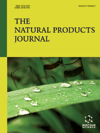- Home
- A-Z Publications
- Natural Products Journal, The
- Previous Issues
- Volume 12, Issue 3, 2022
Natural Products Journal, The - Volume 12, Issue 3, 2022
Volume 12, Issue 3, 2022
-
-
Saponins in Management of Hepatic Disorders: A Review
More LessAuthors: Jasmine Chaudhary, Akash Jain and Randhir DahiyaLiver disease is one of the major factors responsible for increased morbidity and mortality worldwide. Presently, limited therapeutic options are available to treat liver diseases. Moreover, allopathic medications are a double-edged sword due to their unfavorable side effects and exaggerated cost of therapy associated with the treatment. Transplantation of the liver is still in infancy state and is associated with staggering cost a Read More
-
-
-
Development of Metal-Based Drugs and Application in Clinical Treatment
More LessAuthors: Yi M. Shao, Bold Sharavyn, Ping Huang, Hua Naranmandura and Qian Qian WangMetals occur naturally in soil and many kinds of rocks, particularly in minerals and ores, which also play a vital role in living systems such as plants and animals. Over the large time scale, metal evolution from toxins to drugs has achieved a milestone mean in medicine. Currently, a few metal-based drugs (i.e., metallodrugs) have been used in the clinic to treat patients with different medical conditions, making exciting new dev Read More
-
-
-
Dichrostachys cinerea: Ethnomedicinal Uses, Phytochemistry and Pharmacological Activities - A Review
More LessAuthors: Ofentse Mazimba, Tebogo E. Kwape and Goabaone GaobotseIndigenous and medicinal plants have proven crucial to the health of mankind for a very long time. Dichrostachys cinerea is a traditional herb used in the treatment of a variety of human diseases in African and Indian traditional medicine. This paper reviews the ethnomedicinal uses, phytochemical constituents, pharmacology, and toxicity of D. cinerea, in order to provide scientific consensus for further research and e Read More
-
-
-
Chemical Constituents, Ethnomedicinal Uses, Pharmacology, and Toxicity of Dysphania Ambrosioides (L.) Mosyakin & Clemants, Formerly Chenopodium Ambrosioides L.
More LessBackground: Dysphania ambrosioides (L.) Mosyakin & Clemants is an aromatic herb native to South America but also distributed widely throughout Africa and Europe. This plant is traditionally used to treat various ailments including pain and swellings, flu, parasitic diseases and is used as an analgesic, antipyretic, and wound healing. Phytochemical analyses of D. ambrosioides revealed the presence of terpenoids, flavonoids, c Read More
-
-
-
Anti Diabetic Evaluation of Methanolic Extract of Psoralea corylifolia L. & Psoralea esculenta L. Seeds in Streptozotocin Induced Diabetic Rats and Histopathological Changes in Diabetic Rats Pancreas: A Comparative Study
More LessAuthors: Neeraj Singh, Girendra K. Gautam, Akash Ved and Karuna S. ShuklaBackground: Diabetes mellitus is a metabolic disorder which results in a high level of sugar due to inadequacy in insulin secretion. The high sugar level in diabetes is linked to the impairment and dysfunction of the eyes, kidneys, blood vessels, nerves, and heart. In the current research, herbal medicines have been explored because of the side effects associated with oral hypoglycemic therapy of hyperglycemia. Herbal medicin Read More
-
-
-
Echinochrome Pigment Improves Male Rats' Fertility
More LessBackground: Infertility is the first-rate public health problem affecting one in five married couples globally; male causes embody a significant proportion. Natural products could be an alternative or complementary inexpensive treatment for such matters. Echinochrome (Ech) is a natural quinone pigment obtained from sea urchin, and it was confirmed to possess many pharmacological properties due to its chemical activit Read More
-
-
-
Holothuria arenicola Extract Attenuated Hepatic Steatosis in Splenectomized Rat Fed High Fat Diet
More LessAuthors: Shimaa A. Sadek, Asmaa E. Farouk, Sohair R. Fahmy and Amel M. SolimanBackground: Non-alcoholic fatty liver disease (NAFLD) is a considerable public health concern due to the excessive dietary consumption of high caloric diet and subsequent obesity. Additionally, splenectomy is considered one of the major common risk factors for NAFLD. Objective: Regardless of the non-alcoholic fatty liver disease (NAFLD) being the most common chronic disorder, there is no effective cure for it. Therefore, the Read More
-
Volumes & issues
Most Read This Month
Article
content/journals/npj
Journal
10
5
false
en


